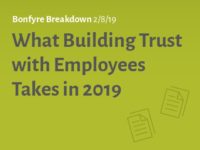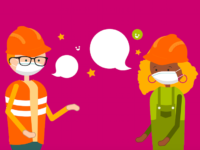In today’s work culture, collaboration is key. Employees feel valued when their contributions are accepted and make a difference. Through teamwork with employees and management alike, a collaborative environment allows employees to share ideas and feel recognized. This type of autonomy and responsibility can have a positive impact on employee engagement survey plans. A thoughtful engagement survey plan can reveal what’s working and what needs tweaking, helping to improve the overall workplace culture. Effective collaboration across the board is essential for this. With Artificial Intelligence (AI), we can make communication smoother, cut down on tedious tasks, and get deeper insights to make collaboration efforts even stronger. Let’s dive into how smart collaboration and AI can change the game in how we connect and work with our teams.
What is Workplace Collaboration?
Collaboration is the process of two or more people or organizations working together to complete a task or achieve a goal. In a synergetic, well-operating workplace, collaboration involves pooling knowledge, resources, and talents to solve problems, innovate, and drive projects forward.
Collaboration is crucial for the workforce as it boosts morale among employees while encouraging the free flow of ideas. When done effectively, workplace collaboration can lead to creative solutions and new initiatives that might not otherwise emerge.
All talent has a diverse skill set and unique experience that makes them an asset to a company. Collaboration taps into what makes an employee so invaluable and harnesses those talents for the greater good of the company’s culture and output.
The value of collaboration in the workforce cannot be overstated. It lifts spirits, creating an energized atmosphere where everyone feels they’re contributing to something meaningful.
Moreover, collaboration fosters a tight-knit community within the workplace. Employees don’t just see themselves as cogs in a machine but as valued members of a cohesive team working towards common goals.
This sense of belonging boosts morale and motivation, making each person feel integral to the company’s success. For instance, when a project triumphs, it’s a collective win that everyone shares, reinforcing the bond among team members and amplifying their sense of achievement.
How to Make Your Collaboration Smart
Collaboration is more than just working together. It’s a catalyst for innovation, a builder of communities, and a key ingredient for fostering a vibrant, productive work environment where every individual can thrive. Making your collaboration smart, makes technology work for your employees, so they can work for your company more efficiently.
Smart collaboration in the workplace is enhanced by AI technologies. It represents an integration of intelligence and automation to streamline communication, decision-making, and project management.
AI tools analyze vast amounts of data to provide actionable insights, facilitating more strategic planning and execution. They enable predictive analytics for better forecasting and resource allocation, ensuring teams are aligned and focused on high-impact activities.
At its core, smart collaboration through AI elevates workplace efficiency and innovation. When used properly, it empowers organizations to navigate complex challenges with agility and precision. Let’s take a look at the different levels of collaboration in the workplace and how to make it smarter with AI.
The Importance of Employee-to-Employee Collaboration
Employees are the heart of the operation. You want them to work together to keep the entire body moving efficiently.
Employee-to-employee collaboration is a cornerstone for nurturing a vibrant and productive workplace culture. Sometimes work can be a source of stress. This stress can feel heightened in remote jobs where employees may feel isolated.
Collaboration among employees fosters a sense of connection. Interacting with peers can lead to higher job satisfaction and a strong sense of team spirit. This kind of collaboration results in real, visible improvements in the work we do.
Tools like Bonfyre take employee collaboration to the next level. Bonfyre enhances interactions among team members by engaging in team-building activities. By sharing personal achievements or cherished memories, employees forge deeper connections, breaking down formal barriers to create a more relaxed and friendly work atmosphere.
Creating a Recognition or Celebration on Bonfyre is a fantastic way to acknowledge the hard work and creativity of team members. Start by crafting a post that highlights the specific project or innovative solution your team has developed.
Be sure to mention the individuals involved by name, celebrating their contributions in detail. Then, tag other coworkers and management in the post to draw attention to these achievements and encourage them to add their own messages of congratulations and support. This meaningful interaction not only boosts morale but also fosters a culture of recognition and appreciation within the workplace, making everyone feel valued and connected.
Why Management Should Foster Collaboration
Management’s commitment to fostering a collaborative environment extends far beyond mere two-way communication. It’s about building a foundation of trust, respect, and mutual growth between employees and the management team.
When managers actively engage with their teams by soliciting feedback and encouraging idea-sharing, it sends a powerful message that each employee’s perspective is important. This democratic approach to leadership not only elevates employee morale but also cultivates a culture of openness and innovation.
A collaborative culture facilitated by engaged management can significantly improve the company’s relationship with its employees. Facilitating a stronger relationship at all levels makes it easier to navigate challenges, implement changes, and achieve strategic goals together.
It positions management as more than just supervisors. Collaboration transforms leaders into mentors and allies in the pursuit of both individual and organizational success.
To boost collaboration between employees and management, incorporate regular brainstorming sessions where employees from various levels can contribute ideas for new projects. Similarly, holding regular one-on-one meetings can provide a more personal platform for employees to voice concerns, aspirations, and suggestions directly to their managers, fostering a deeper sense of individual recognition and belonging.
AI-powered coaching tools play a transformative role in this dynamic by analyzing feedback data from these interactions. These insights enable management to identify patterns, recognize areas needing attention, and understand the impact of their actions on employee satisfaction and performance.
Consequently, management can tailor their strategies to address specific concerns, align with employee expectations, and adjust their leadership styles to better meet the needs of their teams.
In addition, by integrating AI into the feedback loop, companies can proactively address issues before they escalate, predict future trends in employee engagement, and personalize development plans for each team member.
This level of attentiveness and customization enhances the employee experience. Using AI to improve collaboration may lead to higher retention rates, increased productivity, and a more harmonious workplace overall.
Integrating AI Into Your Collaborative Workspace
Expanding on the strategic use of AI tools and platforms for enhancing collaboration is especially important in today’s increasingly remote or hybrid work environments. Bonfyre is an excellent tool for bridging communication gaps and improving collaboration across all levels.
Over one million teams use Microsoft Teams globally. AI Culture Coach from Bonfyre can pull data from Microsoft Teams so you can analyze collaborative efforts throughout the company such as by suggesting specific people to recognize for going above and beyond.
AI can analyze the frequency and quality of interactions within a team to suggest optimal times for brainstorming sessions. It can also highlight when team members might be feeling disconnected and could benefit from more direct engagement. This level of insight helps in tailoring communication strategies, ensuring that collaboration is not just frequent but also effective.
Bonfyre also makes it easier to nurture a collaborative culture through recognition and rewards. Culture Coach can make recommendations for recognition based on specific KPIs chosen by management. When employees get rewarded, they can also be recognized on Bonfyre’s Celebrations Wall. Management can tag other team and management members to share in the celebration. These types of gestures reinforce that collaboration is encouraged, applauded, and rewarded.
The strategic integration of AI tools and platforms into the fabric of company operations transforms collaboration from a buzzword into a tangible asset. It enhances employee engagement, drives efficiency, supports customer satisfaction, bolsters innovation, and strengthens employer branding. As companies navigate the future of work, those who prioritize and effectively manage collaboration will not only survive but thrive, setting new standards for success in their industries.









